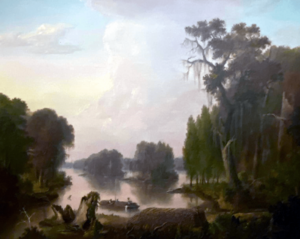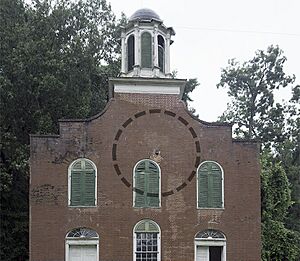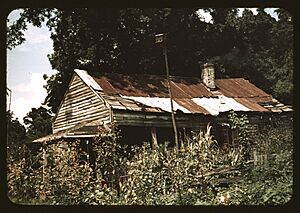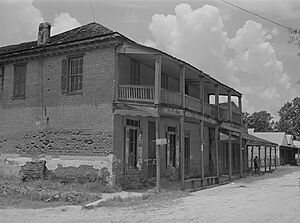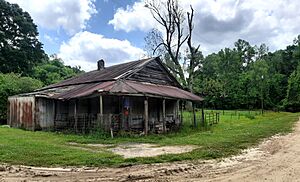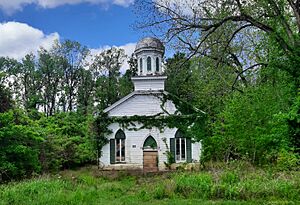Rodney, Mississippi facts for kids
Quick facts for kids
Rodney, Mississippi
|
|
|---|---|
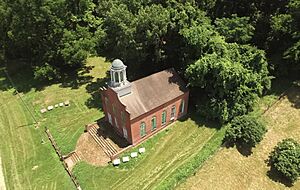
Former First Presbyterian Church
|
|
| Nickname(s):
"Petite Gulf", "Little Gulf"
|
|
| Country | United States |
| State | Mississippi |
| County | Jefferson |
| Founded | 1828 |
| Elevation | 82 ft (25 m) |
| Time zone | UTC-6 (Central (CST)) |
| • Summer (DST) | UTC-5 (CDT) |
| GNIS feature ID | 676809 |
Rodney is a ghost town in Jefferson County, Mississippi, United States. Most of its buildings are gone today. The ones that are left are falling apart. The town often floods, and many buildings have a lot of water damage.
The Rodney Presbyterian Church is being fixed up by a group called the Rodney History And Preservation Society. You can still see damage on the church from the American Civil War. There's even a fake cannonball stuck above the balcony windows to show where a real one hit! Rodney Center Historic District is a special place listed on the National Register of Historic Places.
Rodney is about 32 miles (51 km) northeast of Natchez. It's now about two miles away from the Mississippi River. Between the town and the river are wet, swampy areas. There's even a lake that follows where the river used to flow. On the hills behind Rodney, you can find its cemetery and old army forts from the Civil War.
In the early 1800s, Rodney was a very important place in the region. In 1817, it almost became the capital of Mississippi, missing by only three votes! A special type of cotton called Petit Gulf cotton was created here by Rush Nutt. He also made new ways to use the cotton gin. Rodney became an official town in 1828. It was the main port for the area, with thousands of people living there.
By 1860, Rodney had many businesses, several newspapers, and Oakland College. During the Civil War, soldiers from the Confederate States Army captured sailors from a Union Army ship. The sailors were attending church in Rodney Presbyterian Church. This led to the Union ship firing cannons at the town.
After the war, the Mississippi River changed its path. The railroad also went around Rodney, not through it. Many buildings burned down. The number of people living there dropped a lot. The town stopped being an official town in 1930. By 2010, only a few people were reported to live in Rodney.
Contents
History of Rodney
The area where Rodney is located was an important stop for Native Americans. They traveled along routes around the Mississippi Delta. Old Native American items have been found between the Natchez Trace trail and Rodney. The Natchez people likely used this area to carry their boats between the Mississippi River and White Apple Village.
The French claimed this area in January 1763. They called it "Petite Gulf" because it was a narrow bend in the river. This was different from "Grand Gulf, Mississippi" which was a wider bend upstream. After the French and Indian War, the land went to Great Britain. The first known land was given to a Mr. Campbell in 1772.
Spain took control in 1781. They gave land to many English-speaking settlers in West Florida. American families, like the Nutt and Calvit families, moved to the area that would become Rodney. Spain lost control in 1798. On April 2, 1799, the Mississippi Territory became part of the United States. Three years later, a judge named Thomas Rodney was sent to Jefferson County.
In 1807, a group of soldiers gathered near Rodney to capture Aaron Burr. Burr was being investigated for treason. Thomas Rodney was the judge for Burr's trial. He became the Chief Justice of the Mississippi Territory. The town was named after him in 1814. In the early 1800s, Rodney was more important than Vicksburg or Natchez. In 1817, when Mississippi became a state, Rodney almost became its capital.
How Rodney Grew

Rodney became a busy river port. The town was right on the water, with the river flowing next to its main streets. It was the main place for shipping goods, especially cotton, from a large part of Mississippi. Many workers loaded "millions of pounds of cotton" onto steamboats going to New Orleans. Because there wasn't much money, cotton receipts were used like cash.
Rodney became an important cultural center and became an official town in 1828. In 1830, a resident named Rush Nutt showed how to power cotton gins with steam engines. Different types of cotton seeds were brought in. This led to a new kind of cotton called Petit Gulf cotton. It was strong against diseases and easy to pick. The "seed business" in Rodney sold seeds to places as far away as North Carolina.
The new cotton and the Indian Removal Act of 1830 caused many people to move west. Many early settlers going to Texas passed through Rodney. Their wagons were carried across the river on flatboat ferries to St. Joseph, Louisiana. From 1820 to 1830, Rodney was the main crossing point on the Mississippi River for Americans moving to the Southwest.
Several important buildings were built during this time. These included the Rodney Presbyterian Church and parts of Alcorn University. The first building used for church services also served as a tavern. In 1829, work began on the red-brick Presbyterian church. A year later, Oakland College was started. The college was built on 250 acres (100 ha) near the town. Construction on the college's main building, the Oakland Memorial Chapel, began in 1838.
Plantation homes like Zachary Taylor's Cypress Grove Plantation and Nutt's Laurel Hill were built around Rodney. Before the Civil War, the town had two main newspapers.
However, Rodney's growth started to slow down by the 1840s. A guide from that time said it had been "very unhealthy." Still, it had several stores, a mill, and a church.
Rodney and the Civil War
During the Civil War, Union soldiers were captured at Rodney's Presbyterian Church. The Union Army wanted to control the Mississippi River. This would split the Southern states in half. The USS Rattler was a steamboat that was turned into a light warship. After the Union captured Vicksburg, they controlled river traffic. The Rattler helped keep this control.
In September 1863, the Rattler was anchored near Rodney. The church was easy to see from the river. A church leader invited the Rattler's crew to come ashore for a church service. On Sunday, September 13, 1863, seventeen men from the Rattler went to the 11 AM service. Only one of them brought a gun.
Confederate soldiers surrounded the church when the music was loud. They entered the building and quickly captured the Union soldiers. Some people in the church helped them. When the ship heard what happened, the Rattler started firing cannons at the town. A cannonball hit the church and got stuck above a window. The firing stopped when the Confederate soldiers threatened to harm their prisoners.
Why Rodney Declined
Rodney slowly changed from a big port to a ghost town after the river moved. In 1860, Rodney had banks, newspapers, schools, a hotel, and over 35 stores. Thousands of people lived there.
During the Civil War, the Mississippi River started to change its path. A sand bar formed upstream and pushed the river west. Rodney's old shipping channel became a swamp. The Rodney Landing was moved several miles away from the town. Many men who left for the war never came back. Many businesses that closed never reopened.
In 1869, a fire destroyed most of the town's buildings. The Presbyterian church survived. In 1880, new businesses were opened by German and Irish immigrants. The town also had several yellow fever outbreaks. The railroad line went through Fayette, the county seat, and bypassed Rodney. No boats used Rodney's landing after 1900. In 1930, Governor Theodore G. Bilbo officially ended Rodney's status as a town. By 1938, Rodney was called a "ghost river town" that died when the railroad passed it by.
The writer Eudora Welty found the town in this state of decline. Rodney became a setting in her books, like The Robber Bridegroom. Welty wrote that "The river had gone, three miles away... It came back only in flood." A photographer named Marion Post Wolcott took pictures of Rodney around 1940. She called it a "fantastic deserted town."
Buildings Still Standing
Today, a ruined cemetery, a few stores, a couple of churches, and some houses remain. They are all in different states of damage. The red-brick Rodney Presbyterian Church, built in 1832, is the oldest building left. It has special fan-shaped windows above the doors. The church was lit with oil lamps and heated with stoves. There's a special area in the back for enslaved people, reached by a winding staircase.
The church was built on high ground to avoid floods. It has been on the National Register of Historic Places since 1972. The Rodney History and Preservation Society bought the church to fix it. When they restored the church, they kept the hole from the Civil War cannonball. A fake cannonball was placed in the wall. Next to the church is a cemetery with very old graves. Many early settlers from Louisiana brought their dead here to be buried on high ground away from floods.
Mt. Zion Baptist Church was built in 1851. It has a mix of building styles. The pointed arches are Greek Revival, the triangle-shaped roof part is Gothic Revival, and the round dome on top is federal-style. Mt. Zion Baptist Church used to have a white congregation. It became a mostly African American church after white people left the town. Now, it is completely empty.
Because the Mississippi River changed course, the church has flooded many times. You can see clear flood damage, like water lines and rotted floors. The road sign pointing to the church can only be seen in autumn when the leaves fall off the vines covering it. The church members who are still alive formed a new church, Greater Mount Zion, several miles away from the flood zone.
Alston's Grocery, built around 1840, is south of the Presbyterian Church. It was once at a busy intersection. The Sacred Heart Catholic Church was built in Rodney around 1868. The whole building was moved to Grand Gulf Military State Park in 1983. The Masonic lodge, with its triangle-shaped front, was built around 1890. Only a few people still live in the area, and most of the remaining buildings are empty.
Geography of Rodney
Rodney is located near the southern end of the Natchez Trace. This is a forest trail that goes for hundreds of miles across North America. The trail started from animal paths along a ridge. The town is about 32 miles (51 km) northeast of Natchez. It is south of Bayou Pierre (Mississippi) and about 2 miles inland from the east bank of the Mississippi River.
Rodney sits on hills that were once next to the river. These hills are part of the Mississippi River watershed. Wet areas, including a lake that follows the river's old path, are just west of the town. The town is at a low elevation, so it often floods. When the river flowed past Rodney, its spot on the lower hills above steep banks was perfect for a river landing. Old army forts from the Civil War are still on the hills above the town.
Famous People from Rodney
- James Cessor, who was a member of the Mississippi House of Representatives from 1871 to 1877.
- Thomas Hinds Duggan, a former member of the Texas Senate.
- Bill Foster, a famous baseball player in the Baseball Hall of Fame.
- Charles Pasquale Greco, who was a Bishop and a leader for the Knights of Columbus.
- Reuben C. Weddington, a former member of the Arkansas House of Representatives.
- Zachary Taylor, the 12th president of the United States, had his Buena Vista plantation just south of Rodney.




